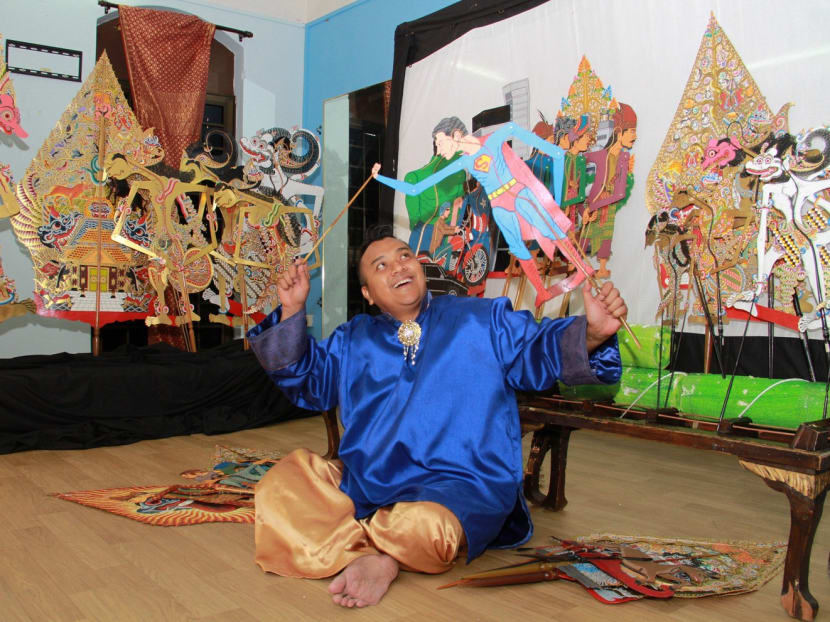Wayang kulit with a superhero twist
SINGAPORE — The traditional art of wayang kulit, or puppet shadow play, will take centre stage at tomorrow’s annual Aliwal Arts Night Crawl. This year’s Rasa Wayang edition, however, will feature a contemporary twist.


SINGAPORE — The traditional art of wayang kulit, or puppet shadow play, will take centre stage at tomorrow’s annual Aliwal Arts Night Crawl. This year’s Rasa Wayang edition, however, will feature a contemporary twist.
Traditional stories from the Ramayana and Malay legends such as Sang Nila Utama will be retold with “modern and Westernised” puppets inspired by Marvel’s The Avengers, for example. Other puppets will boast elements of street style such as sneakers, beanies and skateboards.
“In traditional wayang kulit, the stories are based on the Ramayana and Mahabharata, so it is always about good versus evil — this is timeless. So when we put in these modern (and Western) elements or superheroes, it is also about good versus evil,” said Adel Dzulkarnaen Ahmad, 41, managing director of Sri Warisan Som Said Performing Arts, which will be performing a piece based on the stories of the Ramayana.
Some of the puppets in this wayang kulit performance will bear a resemblance — in design and costume colours — to popular contemporary heroes like The Incredible Hulk, Iron Man and Captain America, but will retain the traditional shapes and silhouettes of wayang kulit puppets. They are also crafted with the same traditional materials, such as buffalo skin and horns.
Sri Warisan, founded by Adel’s mother and Cultural Medallion recipient Som Said, also uses modern Singaporean icons in its wayang kulit performances, such as the Merlion and Gardens by the Bay.
Street-art collective RSCLS will be putting up its first experimental roving installation that fuses street art with wayang kulit at the Aliwal Night Crawl. Like Sri Warisan, it has retained the traditional silhouettes of the puppets, but incorporated new elements such as having the characters sport sneakers, beanies, and skateboards.
RSCLS will debut a roving 1.9m-tall “mobile lantern” called the Fantastic Mythluminator, which will move to four different locations around the vicinity and stop for about an hour “in areas that are not normally used, like the back and hidden alleys”.
This installation will involve shadows cast from the street-art-inspired puppets against a static backdrop of the Central Business District, incorporated with a mishmash of traditional and modern symbols: The Gunungan (a puppet shaped like a mountain), the Merlion and the Death Star from Star Wars. The puppets will move along to audio mixed and edited to include gamelan (traditional ensemble) music as well as Star Wars-inspired sounds of explosions and lasers.
“Culture can evolve with time, culture can change … We can’t expect the younger generation to sit down and listen to a story coming from the Hindu epic in the traditional way,” said RSCLS co-founder Mohammed Zulkarnaen Othman, 37, more commonly known by his artist moniker, Zero.
Similarly, Adel, who has been practising wayang kulit since 2000, said the traditional art form is often perceived as “boring” by the younger generation, which is why he and his team of 26 instructors at Sri Warisan aim to produce wayang kulit performances that are “more relevant and cool” while preserving its heritage.
Using modern puppets alongside their traditional counterparts will also allow for inter-generational conversations, Adel said.
“The older generation will know (the older heroes) that the children might not know, so there’s an interaction or conversation over there … it goes both ways (for modern superheroes as well),” he explained.
Muhammad Hafiz Bin Rawi, 21, who is currently training as a dalang (puppet master) said it is rare for today’s youth to be interested in gamelan or wayang kulit, and he is more the exception than the norm.
“I like the presentation of wayang kulit in its traditional format. However, I do believe that the addition of creative new characters and the incorporation of modern stories would help in attracting younger audiences ... It’s a communal experience that technology can augment, but cannot replace,” he said.
Adel revealed that he has seen a revival of wayang kulit in recent years. “The art form will remain, but we need to reach out to as many (people) as possible. It was a dying art form that had been dormant since 1985 … but now, because of the revival, there’s the traditional wayang kulit, which is still being upheld, and there’s also the contemporary wayang kulit,” he said.
The familiarity with “modern mythology” that the current generation grew up with, such as Star Wars and Lord of the Rings, will help attract new and younger audiences, but efforts need to be conducted “sustainably”, added Zulkarnaen, such as via regular performances.
Into its fifth edition, Aliwal Arts Centre’s annual arts festival will feature over 30 programmes, performances and workshops, and also go car-free for the first time. Supported by Streets for People, an initiative by the Urban Redevelopment Authority of Singapore, the roads from Aliwal Street to Bali Lane will be closed to vehicles from 5pm.
Previous editions of the festival focused on other traditional art forms such as masks and batik art.
For more information, visit www.aliwalartscentre.sg/events/aliwalanc17





